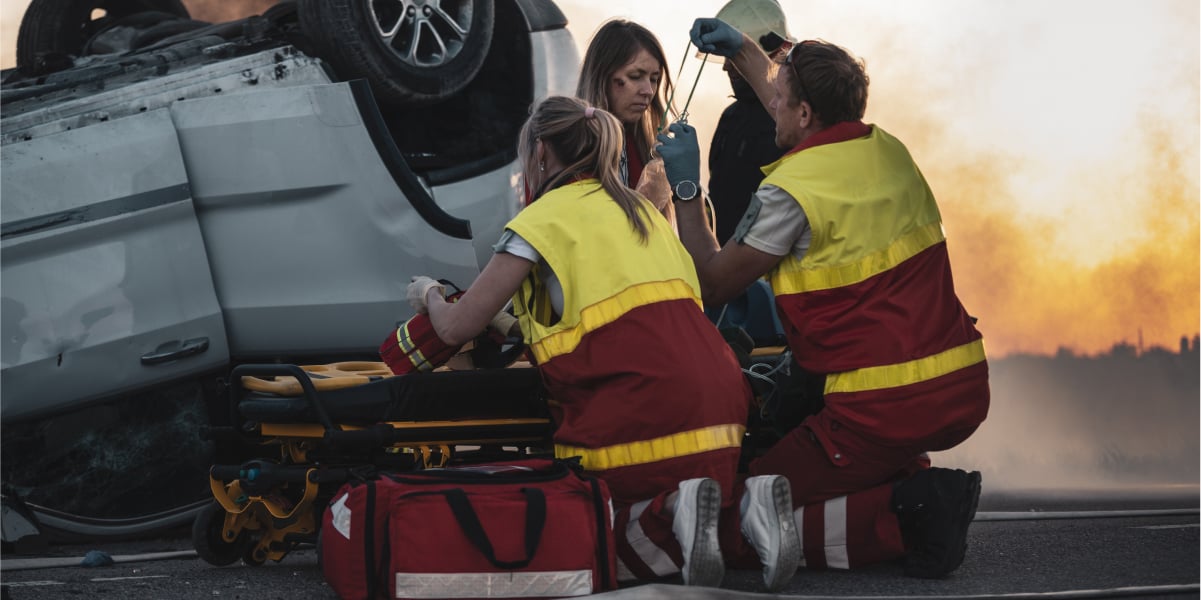Despite progress in reducing the number of teen driving accidents, teen drivers continue to be a leading cause of fatal car accidents. The progress made over the last several decades in reducing the number of teen motor vehicle accidents is linked to a broad range of effective measures, including graduated driver’s license programs, zero tolerance policies for teen drinking and driving, and public information campaigns. Despite these improvements, the toll in human life and serious debilitating injuries caused by teen drivers remains high. A quick look at a few statistics provided by the Center for Disease Control and Prevention (CDC) illustrates the problem.
Car accidents are the leading cause of teen deaths accounting for one in three teen driving fatalities.
- Drivers from age 16 to 19 are four times more likely to be involved in a collision on a per mile basis.
- 3,000 teenage drivers die in motor vehicle related fatalities annually.
- Emergency rooms treat 350,000 teens for car accident-related injuries annually.
While significant improvement has been made, accidents involving teen drivers that cause catastrophic injury and wrongful death remain a serious problem. Graduated driver’s license programs have been the most effective measures in reducing these rates.
Graduated driver licensing systems (GDLS) were created to give new drivers driving skill and experience gradually and in low-risk driving environments. There are usually three stages that the drivers pass to reach full driving privileges. The stages start by the driver obtaining a learner’s permit, then they progress to a restricted, provisional or probationary driver’s license. Finally, the driver receives a full driver’s license. Graduated driver’s licensing typically restricts nighttime, unsupervised driving, and expressway driving during initial stages. However, these restrictions are lifted with further testing of the individual and additional time.
A graduated driver’s license program grants driving privileges to new, inexperienced teen drivers in stages. A teen driver with a new provisional driver’s license may not drive between the hours of 10 p.m. and 5 a.m. (Sunday through Thursday) or 11:30 p.m. to 6 a.m. (Friday through Saturday). A new teen driver with a provisional license also is subject to a zero-tolerance policy for drinking and driving, so any measurable amount of alcohol in his or her system constitutes drunk driving. Many states also restrict the number and age of passengers a teen driver may transport, while other states do not impose such a restriction.
Recent studies have shown the effectiveness of courts gradually granting driving privileges to new, inexperienced teen drivers. This type of graduated driving policy is designed to eliminate the particular risk factors that often lead inexperienced teen drivers to be more likely involved in a motor vehicle collision. A study conducted by the Johns Hopkins Bloomberg School of Public Health’s Center for Injury Research and Policy found that graduated license programs have reduced teen driving fatalities by 11 percent. These programs also reduced teen driving fatalities by as much as 20 percent amongst 16-year-olds.
The car accident insurance industry overall supports graduated license programs. However, there are several youth rights advocates that have accused car accident insurance companies of charging premiums to drivers in graduated driving licensing jurisdictions nearly the same as new or young drivers in non-GDL jurisdictions. These groups feel the insurance premium rates should be considerably lower since graduated licensing programs allegedly reduce the risk of car accidents. This problem is restricted to states with private car insurance. Most state-run auto accident insurance programs do not discriminate based upon driving experience or age.
To see the GDL program in your states, the Governors Highway Safety Association has provided a web page that shows the driving laws and GDL programs in each state.
How Does the New DRIVE-Safe Act Affect Graduated Driver Licensing Systems
Recently, the DRIVE-Safe Act has been signed into law by President Joe Biden. The Developing Responsible Individuals for a Vibrant Economy (DRIVE-Safe) Act addresses the truck driver shortage that is occurring in the trucking and logistics industry. The United States is currently facing a substantial truck driver shortage that is increasing consumer good prices and is hurting the U.S: economy. The DRIVE-Safe Act provides enhanced safety training and creates new job opportunities for young truck drivers. Although 49 states permit people to obtain a commercial driver’s license (CDL) when they are eighteen years of age or older, federal law prohibits operators under twenty-one years of age or from moving goods across state lines. The DRIVE-Safe Act created an apprenticeship program that permits CDL holders under the age of 21 to operate a commercial vehicle across state lines.
This apprenticeship training program helps to ensure these young drivers receive driver training beyond the current standards. The program would also institute rigorous performance benchmarks and safety standards. The new apprenticeship program is established by the DRIVE-Safe Act and requires young truck drivers to complete 240 hours of drivers training with an experienced driver and 400 hours of on-duty training time.
In order for teens to participate in the DRIVE-Safe Act, they must already possess a full driver’s license prior to applying to the program.
Despite bans on teen use of cell phones for talking and texting when driving, the practice remains common. Some traffic safety advocates recommend stricter enforcement of anti-cell phone use laws to further reduce teen driving accidents. If you are injured in a car accident in Georgia, an experienced teen driving accident lawyer can explain your legal rights.
We Know What It Takes To Win!®
If you have been injured or lost a family member due to an accident, contact Montlick Injury Attorneys, Injury Attorneys, for your free consultation today. Our law firm has been representing those who suffer serious injuries or lost a loved one in an accident for over 39 years. Our trial attorneys have recovered billions of dollars for our personal injury clients through negotiated settlements, litigation/lawsuits, settlement of lawsuits, jury verdicts, mediation, and arbitration awards.
Please visit our read Montlick Injury Attorneys reviews to see what our clients have to say about our commitment to exceptional service.
No matter where you are located, our attorneys are just a phone call away, and we will even come to you. Call us nationwide 24 hours day/7 days a week for your Free Consultation at 1-800-LAW-NEED® (1-800-529-6333), or simply dial #WIN® (#946) from your mobile phone. You can also visit us online at Montlick.com and use our Free Case Evaluation Form or Free 24-hour live chat.
Sources:
https://www.nhtsa.gov/road-safety/teen-driving
https://crashstats.nhtsa.dot.gov/Api/Public/ViewPublication/811462
https://www.iihs.org/topics/fatality-statistics/detail/teenagers
https://en.wikipedia.org/wiki/Graduated_driver_licensing#Graduated_licensing_and_insurance


